AudioReputation is reader-supported. When you buy through links on our site, we may earn an affiliate commission Learn More
In this article, we’ll cover everything you need to know about Bluetooth audio receivers. We’ll discuss their main features and advantages over other devices, and provide a list of the top Bluetooth audio receivers on the market. These devices allow you to wirelessly stream music from your mobile device to your speakers or headphones, making them a convenient and versatile solution for audio enthusiasts.
Looking for a way to make your non-Bluetooth speaker system wireless? Our article on 14 best Bluetooth audio receivers in 2024 is here to give you the answers to the most common questions about Bluetooth receivers and to offer you some nice choices. We will discuss the purpose of a Bluetooth receiver, list the things and features you should pay attention to when buying one, and present to you some of the best Bluetooth audio receivers on the market.
Table of Contents
- What is a Bluetooth Audio Receiver?
- Why Do You Need a Bluetooth Audio Receiver?
- Best Bluetooth Audio Receivers – Comparison Table
- What to Look for When Buying a Bluetooth Audio Receiver?
- 14 Best Bluetooth Audio Receivers In 2024
- 1. Best Portable Amp/DAC/Bluetooth Receiver Under $50 – FiiO BTR1K
- 2. The Most Versatile Bluetooth Audio Receiver Under $150 – iFi Zen Blue
- 3. BluDento BLT-HD 5.0 aptX HD HiFi Bluetooth Audio Receiver
- 4. Best Overall – Audioengine B1
- 5. Best Under $150 – Auris Blume
- 6. Best Bluetooth Transceiver Under $50 – Miccus Proven
- 7. Best Bluetooth Transceiver Under $100 – Avantree Oasis Plus
- 8. Best Bluetooth Audio Receiver with Analog Outputs Under $30 – Logitech
- 9. Best for a Multiroom System – Bose SoundTouch
- 10. Best Smart Bluetooth Audio Receiver – WiiM Mini
- 11. 1Mii B03 Bluetooth Transceiver
- 12. Besign BE-RCA
- 13. Best Bluetooth Audio Receiver with Built-In Preamp (For Passive Speakers) – Fosi Audio BT20A
- 14. TP-Link H-100 Bluetooth 4.1 Receiver
- Things to Consider Before Choosing the Best Bluetooth Audio Receivers
- FAQs
- Conclusion
What is a Bluetooth Audio Receiver?
Bluetooth audio receiver (aka Bluetooth adapter or Bluetooth dongle) is a device that receives a Bluetooth signal from a Bluetooth-enabled audio source (phone, tablet, TV, laptop). Bluetooth receiver is supposed to be connected to a non-Bluetooth device like a speaker system or headphones. That way, it makes your non-Bluetooth audio equipment wireless and allows wireless transmission of audio.
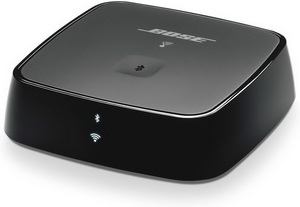
Why Do You Need a Bluetooth Audio Receiver?
The purpose of a Bluetooth audio receiver is pretty obvious. If you want to eliminate the wires connecting your speaker system (or headphones) and your phone/ player, Bluetooth receiver is the thing you need. Also, if you want to stream music from your phone to your non-Bluetooth car’s audio system, Bluetooth receiver is the answer. It’s a simple device with a simple purpose.
Best Bluetooth Audio Receivers – Comparison Table
| Bluetooth Audio Receivers | Rating | Price | Review |
|---|---|---|---|
| FiiO BTR1K | 4.2 | Check Amazon Check Walmart | Read Review |
| iFi Zen Blue | 4.4 | Check Amazon Check Walmart | Read Review |
| BluDento BLT-HD | 4.7 | Check Amazon | Read Review |
| Audioengine B1 | 4.6 | Check Amazon Check Walmart | Read Review |
| Auris Blume | 4.7 | Check Amazon Check Walmart | Read Review |
| Miccus Proven | 4.0 | Check Amazon Check Walmart | Read Review |
| Avantree Oasis Plus | 4.3 | Check Amazon Check Walmart | Read Review |
| Logitech | 4.3 | Check Amazon Check Walmart | Read Review |
| Bose SoundTouch | 4.1 | Check Amazon Check Walmart | Read Review |
| WiiM Mini | 4.5 | Check Amazon Check Walmart | Read Review |
| 1Mii B03 | 4.2 | Check Amazon | Read Review |
| Besign BE-RCA | 4.4 | Check Amazon | Read Review |
| Fosi-Audio-BT20A | 4.5 | Check Amazon Check Walmart | Read Review |
| TP-Link H-100 | 4.4 | Check Amazon | Read Review |
What to Look for When Buying a Bluetooth Audio Receiver?
The first thing we all pay attention to is the price. The market has a lot to offer when it comes to Bluetooth receivers and the price can vary quite a lot. You can find a basic receiver with standard analog audio outputs for less than $50. There are even Bluetooth transceivers (transmitter and receiver in one device) under $50. Bluetooth receivers with more audio connections and those made by more reputable manufacturers (FiiO, AudioEngine, Auris, iFi, etc.) are much pricier (over $150).
Once you establish your budget, you have to think about two things – available audio connections and Bluetooth characteristics (Bluetooth version, range, Bluetooth codecs, etc.).
Depending on the available audio connections (inputs) on your non-Bluetooth speakers, you should be looking for the receiver with the corresponding outputs. So, it doesn’t really matter if the receiver has digital outputs if your speaker has only analog inputs – you don’t have to spend extra money if all you need is a receiver with analog outputs.
The second thing to pay attention to is the Bluetooth connection. Not all the receivers provide reliable connection, long range, and performance without any audio delay. In general, you should be looking for a receiver with one of the latest Bluetooth versions (4.0, 4.1, 5.0), with the longest possible range (in some cases, you can get more than 300ft of unobstructed range), and with a long list of supported Bluetooth audio codecs. All the Bluetooth receivers will support the most common SBC and AAC. More advanced (and pricier) receivers will support at least aptX. Receivers that are, at the same time, transmitters, will also support aptX LL. The most expensive receivers also support aptX HD, which is one of the most advanced Bluetooth codecs that guarantees the best possible sound quality.
One additional thing to pay attention to when looking for a receiver for your non-Bluetooth headphones or for your car audio system is the size and portability of the device. You should be looking for something tiny, portable, and battery-operated. If you only want to make your speakers wireless, you don’t really have to pay attention to the portability.
Now that you know all the basic stuff about Bluetooth audio receivers, you can start searching for one. In order to make your search easier and save you some time, we’ve made a list of 14 best Bluetooth audio receivers in 2024. Our top picks come from different manufacturers, different price ranges, and offer different features, but they all deliver great performance for the price. That’s one thing they all have in common. So, without further ado, here’s our selection.
14 Best Bluetooth Audio Receivers In 2024
1. Best Portable Amp/DAC/Bluetooth Receiver Under $50 – FiiO BTR1K
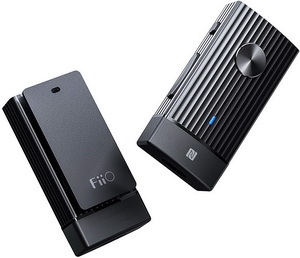
Looking for the best affordable multipurpose device for your headphones? FiiO BTR1K is a perfect choice. It’s a Bluetooth receiver with Bluetooth 5.0 and aptX support, but it’s also a portable headphone amp and DAC. All that for less than 50 bucks.
 What’s in the box?
What’s in the box?
The box contains your FiiO BTR1K, one USB-C charging/audio cable, one lanyard, a short user manual, and a warranty card. AUX cable is not included in the package and, if you want to connect BTR1K to your car audio and use it as a receiver, you have to buy it separately (the recommended cables are FiiO’s L16 and L17).
 Things we like
Things we like
BTR1K is a simple-looking and very compact device. It’s basically a tiny box with a hard and very elegant aluminum chassis. The receiver is less than 2in tall, less than 1in wide, and weighs 20.5g.
On the front panel, you have one large multifunction button (power/reset) and a simple LED indicator (it shows Bluetooth connection status and Bluetooth codec that’s currently in use). On the left, you have another multifunction button (play/pause/call management) and volume controls (also used to play the next/previous song).
On the back, there’s a metal clip and a hole for the lanyard. On the bottom, you have one USB-C port for charging, but can also be used for connecting your PC with the BTR1K (for music playback). On the top, there’s a standard 3.5mm output.
This portable receiver/amp houses Qualcomm’s QCC 305 Bluetooth chip and AK4376A AMP/DAC chip. It can drive any headphones with an impedance ranging from 16-100Ω.
BTR1K features Bluetooth 5.0 with a standard 30ft range. NFC quick pairing is also supported (NFC tag is on the front panel) The Bluetooth chip supports the most common AAC and SBC codecs but also aptX and aptX LL. Depending on the codec in use, the LED indicator on the front panel will be either cyan (AAC), blue (SBC), or purple (aptX or aptX LL). When used as a DAC (connected to your PC via USB-C port), the LED will be white.
The battery has 205mAh capacity and can provide 8h of streaming (when using AAC codec). The recharge takes 1.5 hours.
The amp/DAC/receiver has a built-in mic and, when paired with your phone, it can be used for call management. It can also be used to summon your voice assistant (Siri or Google Assistant).
 Things we don’t like
Things we don’t like
Considering the number of features and overall quality, it would be unreasonable to expect more, but we have to warn you that BTR1K has no balanced headphone outputs and doesn’t support aptX HD. At this price point, the lack of these features is definitely not a dealbreaker.
2. The Most Versatile Bluetooth Audio Receiver Under $150 – iFi Zen Blue
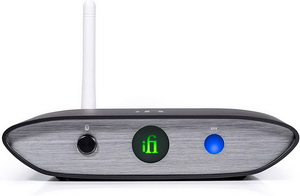
iFi Zen Blue is probably the most capable and most versatile Bluetooth receiver on this list. It has a very interesting set of features that are rarely found in devices in this price range. Among other things, Zen Blue has separate analog and digital stages, it has analog and digital inputs (including balanced 4.4mm line output), and it provides a perfectly reliable wireless connection.
 What’s in the box?
What’s in the box?
Inside the box, there’s your Zen Blue DAC receiver with a detachable antenna, RCA audio cable, power adapter, user manual, and a warranty card. All the other cables are sold separately (TOSLINK, coaxial, balanced).
 Things we like
Things we like
iFi Zen Blue is a little bit larger than other receivers on this list, but it’s still very compact and looks like a tiny router. The chassis is entirely made of aluminum and looks very premium.
On the front panel, you have the Bluetooth pairing button on the left side, a large circle with a backlit iFi logo in the middle, and a sampling rate indicator on the right side. That large iFi logo in the middle doubles as the pairing/codec indicator. The color of the logo will be different depending on the active codec – yellow when the AAC codec is active, green when the SBC is used, blue when aptX is active, magenta when aptX HD is active, cyan when LDAC is used.
All the outputs are on the rear panel. The receiver has separate analog and digital stages. The analog stage includes 4.4mm balanced line output and RCA outputs. The digital stage consists of optical output and coaxial output. Between the analog and digital stages, there’s the output selector (digital/analog). On the back, you will also see the Bluetooth antenna and DC input.
The receiver encases Qualcomm’s QCC5100 Bluetooth chip with an impressive list of supported codecs. Besides the SBC and AAC, the chip supports aptX, aptX HD, LDAC, and HWA codecs. iFi Zen Blue is super-easy to pair and provides a reliable connection within a 100ft range. It can remember up to 7 Bluetooth sources.
Unlike some cheaper DAC receivers, iFi Zen Blue doesn’t use the built-in Bluetooth chip for digital-to-analog conversion. Instead, it has a separate Sabre DAC chip that can process hi-res PCM audio (up to 24bit/192kHz).
The most impressive feature, that’s almost never seen in DAC Bluetooth receivers under $150, is the 4.4mm analog line output (not headphone output). The balanced output provides cleaner sound with less interference.
 Things we don’t like
Things we don’t like
Except for the RCA to RCA cable, other audio cables are not included in the package.
3. BluDento BLT-HD 5.0 aptX HD HiFi Bluetooth Audio Receiver
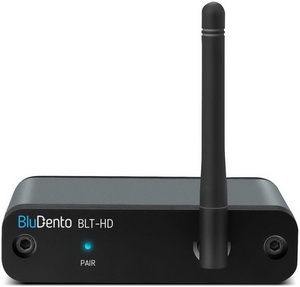
BluDento is a high-performing and highly versatile Bluetooth receiver with multiple audio outputs, including analog and digital. On top of that, BluDento is super-easy to use. It’s not exactly cheap but it’s worth every penny.
 What’s in the box?
What’s in the box?
Inside the packaging, you will find your BlueDento BLT-HD receiver, USB power cable, a set of audio cables (RCA to RCA, 3.5mm to RCA, TOSLINK cable), user manual, and a warranty card. Power adapter and coaxial cable are not included.
 Things we like
Things we like
BlueDento BLT-HD is a simple router-like device. It’s all black, it has an aluminum housing, and it’s compact and unobtrusive. The receiver is less than 4in wide, 3in deep, and 1in tall.
On the front, there’s just an LED Bluetooth indicator and a rotating antenna for extended range. On the back, you have two RCA analog outputs, one digital optical output, and one coaxial output.
The receiver houses Qualcomm’s CSR8675 Bluetooth chip. It features Bluetooth 5.0 and it provides a perfectly reliable wireless connection. The receiver doesn’t support NFC and multipoint pairing. Thanks to the antenna, the receiver has an extended range of 100ft. You should be able to get at least 50ft indoors. The Bluetooth chip supports SBC and AAC but also aptX, aptX Low Latency, and aptX HD. It guarantees high-quality sound, but only when paired with an aptX HD audio source.
The receiver will output the same audio signal from all the outputs at the same time (they are all active simultaneously). To switch between different outputs, you have to use your preamp or DAC device.
 Things we don’t like
Things we don’t like
There’s no output switch on the Bluetooth receiver. The receiver is supposed to be connected to a DAC/preamp that serves as the output selector.
The performance of the receiver depends highly on the power supply – when connected to a PC, there could be some noise or hissing. It’s highly recommended to use a simple phone charger as a power adapter.
4. Best Overall – Audioengine B1
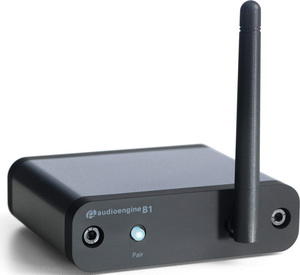
Audioengine B1 is one of the best-performing and highest-rated receivers on the market. It features digital and analog outputs and provides a perfectly reliable wireless connection.
 What’s in the box?
What’s in the box?
Inside the box, you will find your B1 Bluetooth receiver, RCA audio cable, USB to micro USB power cable with a detachable adapter, microfiber product bag, user manual, and a 3-year warranty.
 Things we like
Things we like
Like the previous BlueDento and iFi receivers, B1 looks like a tiny wireless router. It has a hard aluminum chassis and it’s very compact. The device is 4in wide and 3.5in deep.
On the front panel, you have a simple Bluetooth LED indicator and a Bluetooth antenna. On the back, there are audiophile-grade RCA outputs, optical output, and a micro USB power input.
The receiver houses AKM’s AK4396 DAC that supports 24bit hi-res audio sampling. The Bluetooth chip features Bluetooth 5.0. The range is extended and can reach 100ft. NFC and multipoint pairing are not supported. The list of supported codecs includes AAC, SBC, and all the aptX codecs except for the aptX Adaptive. Thanks to the aptX HD, you can stream hi-res audio files wirelessly and get a better-than-CD audio quality.
The device has no buttons or controls. Both audio outputs are active simultaneously and, if you want to select the output, you have to use the amp/DAC/stereo receiver connected to your B1 Bluetooth receiver.
 Things we don’t like
Things we don’t like
Some people may not like the fact that both audio outputs are active at the same time and that there’s no output selector on the device.
5. Best Under $150 – Auris Blume
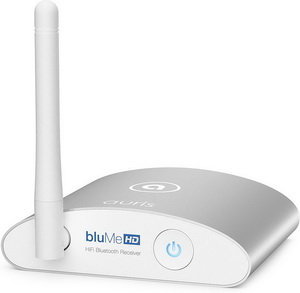
Auris Blume is another great Bluetooth receiver. It’s fairly similar to the previous three, but it looks more attractive and it supports 32bit/384kHz sampling rates. Like the Audioengine receiver, it has both analog and digital outputs. The biggest advantage over Audioengine’s B1 is the price – it’s $60 cheaper than B1.
 What’s in the box?
What’s in the box?
The box contains your Auris Blume Bluetooth receiver, RCA to RCA audio cable, 3.5mm to RCA cable, USB power cable with a detachable wall adapter, QuickStart guide, and a warranty card.
 Things we like
Things we like
Like the previous two, Blume looks like a tiny wireless router, only a bit more sophisticated than the Audioengine and BlueDento. It’s 3.5in wide, 3in deep, and weighs 5.1oz. Blume receiver has a nicely shaped and durable aluminum chassis.
On the front panel, there’s the power button with a Bluetooth indicator and a Bluetooth antenna. On the rear panel, you have two audiophile-grade gold-plated outputs, TOSLINK output, and a micro USB power input.
The installation is completely hassle-free – it’s basically plug-and-play.
The receiver houses Qualcomm’s CSR8675 Bluetooth chip and PCM5102A DAC chip made by Texas Instruments. Thanks to this DAC chip, the receiver supports 32bit/384kHz sampling rates. The Bluetooth chip works on Bluetooth 5.0 and provides a perfectly reliable connection with an extended range (up to 100ft). The Bluetooth chip supports AAC and all the aptX codecs except for the aptX Adaptive. Thanks to aptX HD support, you will get better-than-CD audio quality. Also, thanks to aptX LL support, you can stream audio from your TV and get the audio output without any noticeable delay.
 Things we don’t like
Things we don’t like
The receiver has no output selector/switch – you are supposed to use your amp/preamp or your stereo receiver to select the output.
Also Read: Auris Audio Nirvana.
6. Best Bluetooth Transceiver Under $50 – Miccus Proven
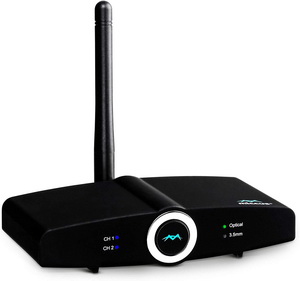
Looking for something cheaper? Well, there’s a bunch of relatively affordable options under $100, or even under $50. Sure, you will have to settle for less reputable brands but they still offer more than satisfying performance for the price. Miccus Proven is the perfect example. It’s an affordable Bluetooth receiver with both analog and digital connections. And it’s also a transmitter. So, it’s a Bluetooth transceiver.
 What’s in the box?
What’s in the box?
Miccus Proven comes with a Bluetooth antenna and a set of cables (AUX, AUX to RCA, optical). The packaging also includes the USB power cable (no adapter), manual, and a warranty card.
 Things we like
Things we like
Miccus Proven is just another router-like device with all the inputs/outputs on the back and all the indicators and buttons on the front.
On the front panel, you have two channel indicators, two input/output indicators (optical and 3.5mm), and one large power/pairing button with the Miccus logo in the middle.
On the rear panel, you have separate TX and RX sections. They both consist of two connection ports – one AUX and one optical. USB power input and TX/RX switch are also located on the back.
Miccus Proven features Bluetooth 4.2. It supports a respectable range of Bluetooth codecs including standard AAC and SBC, but also aptX and aptX LL. However, it doesn’t support aptX HD. Pairing is simple and fast, and the range is quite impressive (300ft).
Like many similar transceivers, Miccus Proven supports bypassing, which means that they can be used as bypass devices between your TV and your soundbar. What does that mean? Well, if you have only one TOSLINK output on your TV and can’t connect two devices directly to your TV, you can run the cable from your TV to the TX section of the receiver and then run another cable from the RX section to the soundbar. So, when you select the optical audio output on your TV, and when the transceiver is in TX mode, the sound will go to the soundbar.
 Things we don’t like
Things we don’t like
The transceiver is small and compact but it’s not portable (it has no built-in battery).
In TX mode, the Miccus Proven can be paired with two headphones simultaneously but it will send audio without noticeable audio lag only if both pairs of headphones support aptX LL.
The transceiver does not support aptX HD, but that shouldn’t be a dealbreaker at this price point.
7. Best Bluetooth Transceiver Under $100 – Avantree Oasis Plus
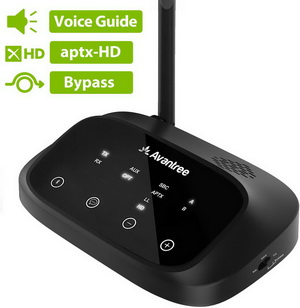
Avantree Oasis Plus is one of the most advanced Bluetooth transceivers under $100. It can be used as a transmitter and as a receiver. It’s one of the rare devices in this price range with aptX HD support, which is very important for the sound quality in the ‘’receiver’’ (RX) mode.
 What’s in the box?
What’s in the box?
Along with the Oasis Plus, you will get a set of audio cables (AUX, AUX to RCA, TOSLINK). You will also get a USB power cable (no adapter), manual, and a warranty card (1-year warranty).
 Things we like
Things we like
The Oasis Plus reminds of some older TP-Link routers, but it’s a bit more compact. It’s entirely made of plastic.
On the top, you have a bunch of indicators (for mode, source, active codec, and connected headphones) and 4 control buttons. The buttons are touch-sensitive and allow you to initiate pairing, turn on/off the voice prompts, and control volume.
On the back, you have two sections (transmitter-TX and receiver-RX). Each section consists of two inputs/outputs – 3.5mm and optical. You will also see the micro USB power input and antenna.
The receiver/transmitter also features LL/HD switch (on the left) that allows you to force a certain type of Bluetooth codec, depending on the content you’re watching/listening (LL for TV watching, HD for music listening). On the right, you will see the power/mode switch.
Oasis Plus features Bluetooth 4.2 with aptX, aptX LL, and aptX HD support. It also supports more common AAC and SBC codecs. The pairing is fast and hassle-free and the range is impressive (300ft+ of unobstructed range).
Just like the previous Miccus Proven transceiver, Oasis Plus can serve as a bypass device between your TV and your soundbar when you don’t have enough optical outputs on your TV and you want to connect both – the soundbar and the Oasis Plus.
 Things we don’t like
Things we don’t like
Oasis Plus is not a portable device – it’s a desktop device without a built-in battery and can’t be used on the go.
The power adapter is not included in the package and you should probably buy one. If you are using the Oasis Plus in receiver mode and if you get power supply from your TV, receiver, or PC, there might be some hissing noise. The adapter provides a much ”cleaner” power supply and eliminates the hissing.
8. Best Bluetooth Audio Receiver with Analog Outputs Under $30 – Logitech
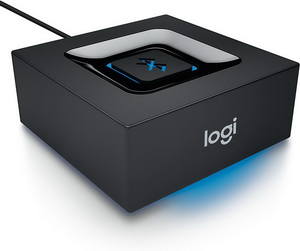
If you want something even cheaper (under $30) with analog inputs only, you have lots of viable options. Logitech Bluetooth receiver is very popular and highly praised by thousands of customers. You can also find this exact Bluetooth receiver under the name Esinkin.
 What’s in the box?
What’s in the box?
Inside the box, there’s your Logitech Bluetooth receiver, power adapter, RCA to AUX cable, manual, and 1-year warranty.
 Things we like
Things we like
The device is simple, boxy, and very small. It has some nice LED lighting on the top and bottom. The device dimensions are 2.25x2x.88in. It weighs 34g/1.2oz.
On the front, there’s just a simple Logi logo. On the top, you have only Bluetooth/pairing button. All the audio outputs are on the back – the receiver has only RCA and AUX outputs (no digital connections). On the back, you will also see the power input.
The device is super simple to install and use. You just have to connect it to your powered speakers, stereo system or AV receiver, plug it in, pair it with your phone/tablet or some other Bluetooth audio source, and you’re ready to go.
The receiver features Bluetooth 3.0. The pairing is simple and the range extends over 30ft (up to 50ft depending on the conditions). Wireless connection is reliable and stable. The receiver supports multipoint pairing so you can pair two devices (phones, tablets) simultaneously with the receiver.
 Things we don’t like
Things we don’t like
The receiver has no digital outputs – it’s analog only.
The receiver has no OFF switch – it stays on all the time (unless you unplug it). Also, the device will repair every time you’re in range, which is sometimes a good thing but it can also be quite annoying.
9. Best for a Multiroom System – Bose SoundTouch
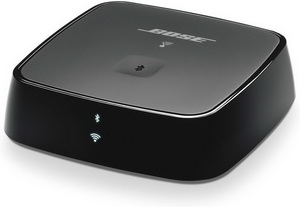
Bose SouindTouch Wireless Link is a bit more advanced than other Bluetooth receivers. It’s one of the rare Bluetooth receivers with wi-fi support and Alexa support. It’s compatible with Bose’s SoundTouch speakers but it can work with other speakers made by other manufacturers.
 What’s in the box?
What’s in the box?
The box contains your Bose SoundTouch, AUX cable, RCA to AUX (F) audio dongle, digital optical audio cable, manual, and a warranty card.
 Things we like
Things we like
The device is boxy with rounded edges and a sophisticated matte black finish. It looks really nice, just like all the other Bose audio equipment.
The button/connection layout is fairly simple. On the top, you have just one pairing button. On the front panel, you have two indicators – wi-fi indicator and Bluetooth indicator. On the rear panel, there is one AUX input and one analog/digital combo output. You will also see the power input, setup port (micro USB), and one button used for disabling wi-fi and Bluetooth connection (it’s basically the ON/OFF switch).
The installation is fairly simple. Just connect the audio output on your SoundTouch receiver with the input on your speaker/soundbar, plug in the receiver, and you are almost ready to go. In fact, if you want to use the Bluetooth capabilities, you can start streaming immediately. If you want wi-fi connectivity, you have to install the SoundTouch app on your Android/iOS device and let it guide you through the setup process. Wi-Fi connectivity is important if you want to stream music through the SoundTouch app via your home Wi-Fi network or if you want to make a multi-room speaker system.
As always, Bose offers very limited info on the device’s specs so we don’t even know what Bluetooth chip was used and what Bluetooth codecs are supported. What we know with certainty is that it doesn’t support aptX LL (it probably doesn’t support aptX HD). The Bluetooth range is average and the connection is stable within that range.
The SoundTouch app is quite useful if you want to manage settings, add music services and internet radio stations, or change presets. We didn’t have any problems with it.
 Things we don’t like
Things we don’t like
The Bose SoundTouch receiver is obviously more expensive than other Bluetooth receivers and it’s not that better than others when it comes to Bluetooth connection. It’s expensive only because of the wi-fi connectivity and compatibility with Bose speakers. You should buy it only if you want to make a multiroom system that includes Bose speakers.
Whether you are using Bluetooth or wi-fi connection for streaming when watching video content, the audio delay is quite noticeable. Based on this, we can make a conclusion that Bose SoundTouch receiver does not support aptX LL. Also, it probably doesn’t support aptX HD.
10. Best Smart Bluetooth Audio Receiver – WiiM Mini
The WiiM Mini is a smart Bluetooth receiver. It is a great choice if you want a device compatible with streaming services (Spotify, Amazon Music, etc) and voice assistants such as Siri and Alexa. It also can be fully controlled via your smartphone.
 What’s in the box?
What’s in the box?
Inside the box, you will find the receiver, a USB-C cable, an aux cable, an aux to RCA cable, a digital optical audio cable/Toslink cable, and a power adapter.
 Things we like
Things we like
The build quality of this receiver is amazing, even though it’s a little more expensive than other options on the list.
It is a smart receiver, meaning it’s fully compatible with streaming services and voice assistants, and you can fully control the device via your smartphone.
This receiver has a feature called multiroom streaming, where you can pair the WiiM Mini with Alexa devices, HomePod, and others and play the same audio simultaneously on different devices.
With this receiver, there’s no loss of quality at all, with hi-res 192k 24-bit playback. Excellent for audiophiles.
You can connect the receiver to the WiiM Home app and fully control it from your smartphone.
 Things we don’t like
Things we don’t like
This Bluetooth audio receiver is a bit expensive. If you need a simple device and don’t care about features such as voice assistant compatibility, it’s best to go for another one.
11. 1Mii B03 Bluetooth Transceiver
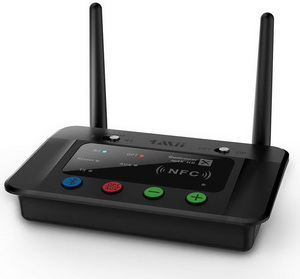
1Mii B03 is a device similar to previously reviewed Oasis Plus and Miccus Proven. So, it’s a transmitter/receiver (transceiver) with analog and digital inputs/outputs and with aptX LL support. It’s relatively affordable and quite easy to use.
 What’s in the box?
What’s in the box?
The box contains your 1Mii Bluetooth transceiver (with undetachable Bluetooth antennas), power adapter, all the audio and power cables (3.5mm, 3.5mm to RCA, TOSLINK, micro USB), user manual, and a warranty card.
 Things we like
Things we like
Like many similar devices, 1Mii B03 looks like a tiny router with two antennas. On the top, you have all the control buttons and indicators. Right at the top, there are the mode switch (Transmitter/Bypass/Receiver) and power switch. Below, there’s a bunch of indicators including mode and source indicators. At the bottom, there are four control buttons (Bluetooth/pairing, source selector, and two volume buttons).
On the back, you have two antennas (on the left and right ends), transmitter and receiver sections (each has one optical and one AUX port), and a micro USB power input in the middle.
The receiver features Bluetooth 4.2 with an extended range (up to 270ft). The pairing is pretty much standard. NFC quick pairing is also supported. In transmitter mode, 1Mii B03 can be paired with two headphones. In the receiver mode, you can pair it with two audio sources. Indoors, the connection is stable within a 100ft range, which is much better than a regular Bluetooth dongle. The Bluetooth chip supports AAC, SBC, aptX, and aptX Low Latency codecs. The product description claims that it supports aptX HD, too but we are not sure about that since there’s no info on aptX HD in the manual.
When used in transmitter mode, 1Mii B03 can serve as a bypass device between your TV and soundbar (in case you don’t have enough audio outputs on your TV).
 Things we don’t like
Things we don’t like
Volume controls work only in the ‘’receiver’’ mode. You can’t use them in TX mode.
In TX mode, the device won’t use aptX LL codec when two headphones are paired with the device. So, the audio delay will be much greater when two headphones are paired.
The info on the aptX HD is not perfectly clear. The product description says that it supports it, but the manual doesn’t say anything about it.
12. Besign BE-RCA
The Besign BE-RCA is a simple but powerful long-range Bluetooth audio receiver. In addition to a 3.5mm port, it has RCA inputs so you can connect it to home theater-style speakers, for example.
 What’s in the box?
What’s in the box?
With the receiver, you get a USB power cable, a 3.5mm audio cable, an RCA to RCA cable, and a user manual.
 Things we like
Things we like
Despite its small size, the Besign BE-RCA has a Bluetooth range of 30m (100ft), longer than most other options on the market. Useful if you want to use it in a large room.
The Besign BE-RCA can connect to RCA speakers and audio monitors. It’s also a good solution for home theaters with an RCA audio output that doesn’t have a Bluetooth function.
The sound streaming quality is excellent even when the source (smartphone, laptop, etc) is far from the device. The latency is very low as well.
The device is very simple to use and has a basic design, excellent if you’re looking for a no-hassle solution for your audio setup.
 Things we don’t like
Things we don’t like
There’s no built-in battery, so the device is not that convenient to use in a car, for example.
There’s no built-in mic.
13. Best Bluetooth Audio Receiver with Built-In Preamp (For Passive Speakers) – Fosi Audio BT20A
The Fosi Audio BT20A is not only a Bluetooth audio receiver but also a 100W x 2 amplifier, meaning it can power passive speakers while reproducing your audio wirelessly. It is an excellent solution for that use case.
 What’s in the box?
What’s in the box?
In the box, you will find the Fosi Audio BT20A, a 24V/4.5A power supply, a user manual, and a 24-month warranty.
 Things we like
Things we like
This audio receiver also functions as a 100W RMS X 2 amplifier, which can improve the sound quality and power passive speakers. However, please make sure your speakers are compatible with the wattage of this audio receiver.
The components inside the Fosi Audio BT20A are of excellent quality. It features two Texas Instruments TPA3116D2 chips.
The audio receiver has a Bluetooth range of up to 50ft and ensures low signal delay/latency in your connection.
In addition to connecting your audio source via Bluetooth, you can also use the RCA inputs.
Features an integrated high-quality EQ.
One of the best options for audiophiles.
 Things we don’t like
Things we don’t like
Doesn’t come with any cables, unlike most other options.
You can’t connect it to active speakers.
14. TP-Link H-100 Bluetooth 4.1 Receiver
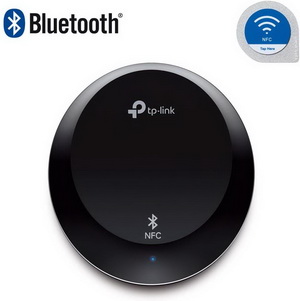
The last device on our list comes from a very reputable networking equipment manufacturer. TP-Link H-100 Bluetooth receiver looks like a Chromecast Audio dongle but with Bluetooth connectivity instead of wi-fi. It’s an inexpensive, simple Bluetooth dongle, designed for car audio systems.
 What’s in the box?
What’s in the box?
Along with the H-100, you will get a USB power cable, 3.5mm audio cable, 3.5mm to RCA cable, power adapter, user guide, and 1-year warranty.
 Things we like
Things we like
H-100 looks quite stylish and sophisticated. It’s circular, with a single LED Bluetooth indicator and NFC tag for quick pairing on the top. All the connections are on the back – the receiver has one AUX output and one micro USB power input. There are no buttons of any kind – you have to use your phone to control the playback or adjust the volume.
H-100 features Bluetooth 4.1. The device turns on when you connect it to the power source and it’s immediately in pairing mode. NFC quick pairing is supported, too so you can just tap the receiver with your phone and you are ready to go. The receiver supports multipoint pairing (pair up to two devices simultaneously). Only the most common AAC and SBC codecs are supported. The range extends well over 50ft and the connection is stable within that range.
 Things we don’t like
Things we don’t like
H-100 has no battery and it’s not made for on-the-go use.
The lack of controls makes it cleaner but some people prefer having some basic controls on the receiver itself.
H-100 does not support advanced codecs from the aptX family.
This is the end of our list of 14 best Bluetooth audio receivers in 2024. Hopefully, it helped you find the receiver that meets your requirements. In case you have some additional questions about Bluetooth receivers, read our FAQ section.
Things to Consider Before Choosing the Best Bluetooth Audio Receivers
When choosing the best Bluetooth audio receiver, there are several factors to consider. These include the audio quality, connectivity options, compatibility with devices, ease of use, and additional features such as NFC pairing and aptX support.
There are many factors you should keep in mind when shopping for a Bluetooth audio receiver. We will list and discuss them in-depth below.
Portability
Whether you want a Bluetooth audio receiver for home use or to take with you to the office, parties, use in your car, and so on, taking into account the size of the device is important.
One of the most portable Bluetooth audio receivers on the list is the FiiO BTR1K. Its reduced size is excellent if you’re looking for portability in a simple device. The WiiM Mini is a great choice if you want smart features, but while you can take it on the go, it’s more convenient for home use.
Audio Inputs and Outputs
When it comes to audio inputs and outputs, it is important that you take into consideration the model of your speakers. Some work with a 3.5mm cable, while others with RCA ones. Make sure the Bluetooth audio receiver you choose is compatible with the audio outputs of your speaker.
Audio Quality
Most modern Bluetooth audio receivers offer decent audio quality for most listeners, but some of the cheaper ones might be lacking in that department. In that case, it’s best to invest in a slightly more expensive option.
For the audiophiles, you might want to look at what components are inside the audio receiver and specifications such as the bitrate. An excellent option regarding audio quality is the Fosi Audio BT20A.
Range and Connectivity
It’s very important to check the Bluetooth range of an audio receiver. This will dictate how far from the receiver your smartphone or device can be without any loss of quality. On the market, you will find receivers with a Bluetooth range of 50ft up to 270ft or more.
Compatibility
Regarding compatibility, most Bluetooth audio receivers in the market are compatible with the majority of consumer devices: laptops, smartphones, tablets, etc. The most important factor is to make sure they’re compatible with the audio output of your speakers, as we said before.
Wired Connectivity Options
Even if you are mainly using your audio receiver via Bluetooth, some offer extra audio inputs and wired connectivity options that make them more versatile. The Fosi Audio BT20A, for example, can also be used with RCA.
Power Source
Most Bluetooth audio receivers are powered with a standard AC adapter. You will also find some options in the market that can be powered via battery and USB, which is useful if you want a portable solution for the go.
Controls and User Interface
The controls and user interface of each Bluetooth audio receiver will vary. You can find simple ones that won’t offer any customizable parameters, as well as devices that feature a dedicated smartphone app or a built-in equalizer, for example.
FAQs
A: We don’t have a definite or just one answer to that question. It all depends on your budget and your needs. If you need an affordable and portable Bluetooth receiver for your headphones, FiiO BTR1K is a great choice. If you need a receiver for your speaker system, Audioengine B1, Auris Blume, and iFi Zen Blue are all great options. If you need a two-in-one device (transmitter/receiver), there are numerous affordable options including TaoTronics, AUKEY, Avantree, and Mpow transceivers.
A: Of course, you can. And it’s quite simple. Check the available audio inputs on your stereo receiver and look for a Bluetooth audio receiver with the corresponding outputs (AUX, RCA, or digital). Connecting the Bluetooth receiver to your stereo receiver is done in seconds.
A: It’s pretty simple. Connect the receiver to your speakers, stereo receiver, or some other non-Bluetooth audio device, plug in the receiver, turn it on, pair it with your phone like you would pair any headphones, and you can start streaming music wirelessly.
A: As their names imply, they have a different purpose. Bluetooth transmitter is connected to a non-Bluetooth audio source (CD player, TV, mp3 player, etc.) and it transmits/sends the audio signal to a Bluetooth-enabled sound output device (Bluetooth headphones, Bluetooth speaker). Bluetooth receivers, on the other hand, are connected to a non-Bluetooth sound output device and they receive the Bluetooth audio signal sent from a Bluetooth-enabled audio source.
A: Yes, most Bluetooth adapters are pretty good. The set of features, audio quality, and the Bluetooth range will vary with the price, but all the receivers on our list of 14 best Bluetooth receivers will deliver more than satisfying performance for the price.
A: No, they are not. Different Bluetooth adapters/receivers have different features, different audio outputs, they have different Bluetooth versions, and support different Bluetooth profiles and audio codecs. So, you should choose carefully and avoid buying something that you don’t need.
A: Bluetooth dongle and Bluetooth adapter are the terms used to describe Bluetooth receivers, Bluetooth transmitters, and Bluetooth transceivers. It can be confusing since one term can be used for a transmitter and for a receiver so you have to be careful when buying a Bluetooth dongle/adapter and check if the device is a transmitter, receiver, or both. If you are not careful, you may end up with a transmitter when you actually need a receiver.
Conclusion
These are the 14 best Bluetooth audio receivers in 2024. Luckily, the market is flooded with options, and it’s up to you to choose what is the best device for your particular use case.
Some of our favorite receivers from the list include the FiiO BTR1K (best for portable use), Bose SoundTouch (best for home use), and the Fosi Audio BT20A (best for audiophiles looking for a Bluetooth receiver with integrated preamp). Remember to research extensively before you make your choice.
Thank you for reading this article. We hope you found the perfect Bluetooth audio receiver for you. If you’re into home audio, make sure to check our related articles. Feel free to comment in case you have any questions or suggestions!

Hello, my name is James Longman.
I’m a writer and editor at AudioReputation. I disassembled my first portable AM/FM radio when I was only 8. At the age of 11, I burned the circuit board on my old boombox cassette player. I’m not going to explain how but it was reckless and stupid.
Since then, I have become much more careful around radios, boomboxes, and other audio devices (at least, I like to think so) but I have never lost the passion for audio equipment. Throughout 20 years of my professional career, I’ve been working for various audio equipment manufacturers and even started building speakers on my own in my little workshop.
I love the work we do here at AudioReputation. Testing, comparing, and evaluating all kinds of audio devices (speakers, soundbars, headphones, home theater systems, etc.) is something I truly enjoy. I try to be unbiased and give you my honest opinion on every piece of equipment I test. Still, you should take my reviews with a pinch of salt and always be just a little bit skeptical. The fact that I liked some speaker or soundbar doesn’t mean that you are going to love it. If you have the opportunity, you should test it/hear it before buying it.





You have no idea how much this helped me. Your detail and clarity are perfect. Thanks!